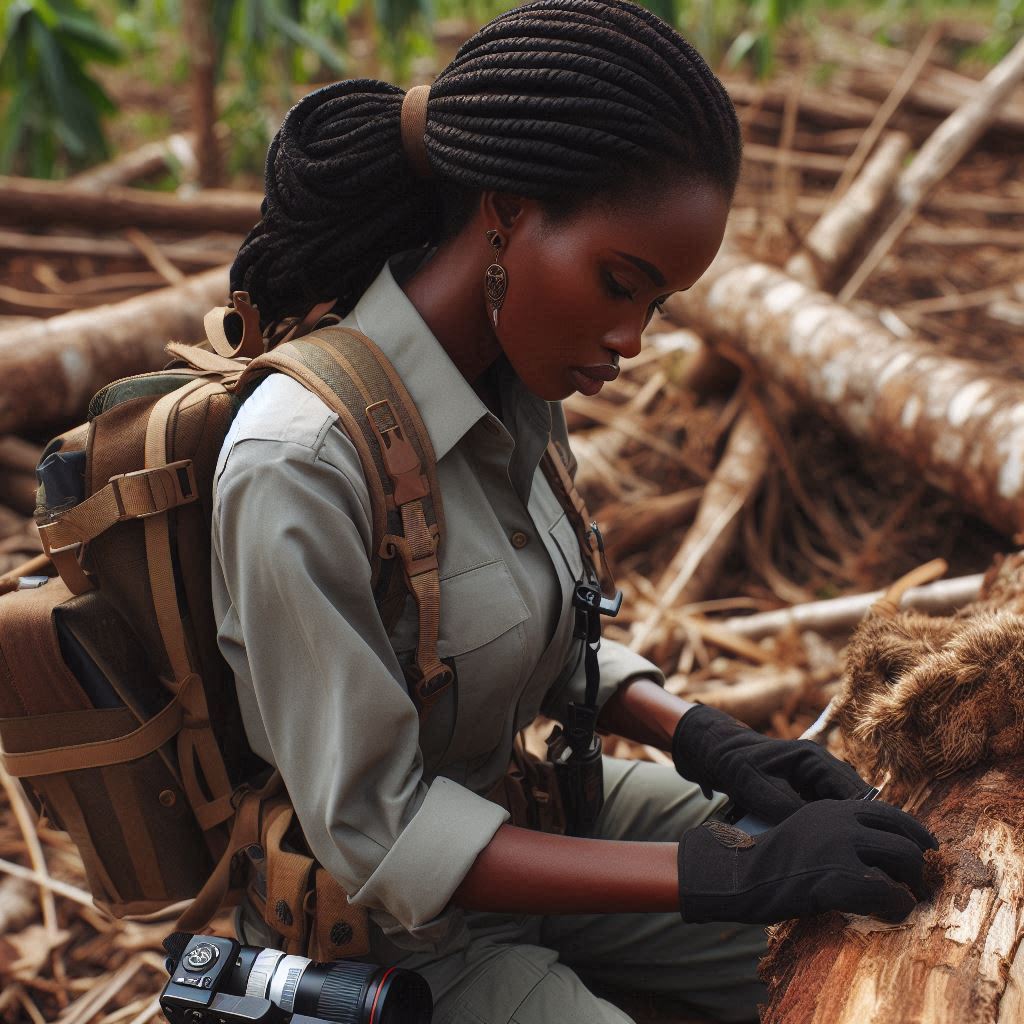Introduction
The management of wildlife in Nigeria is a multifaceted endeavor, encompassing a wide array of techniques and strategies aimed at conserving the nation’s rich biodiversity.
As one of the most biologically diverse countries in the world, Nigeria is home to a plethora of unique and endangered species, ranging from majestic elephants and lions to rare primates and vibrant bird species.
The importance of wildlife conservation in Nigeria cannot be overstated.
These diverse ecosystems provide invaluable ecological services, including pollination, seed dispersal, and nutrient cycling, which are essential for the health and well-being of both wildlife and humans.
Furthermore, wildlife-based tourism contributes significantly to the country’s economy, generating revenue, creating jobs, and supporting local communities.
Effective wildlife management techniques are therefore essential to ensure the sustainable use and conservation of Nigeria’s natural resources.
From habitat restoration and protected area management to community-based conservation initiatives and anti-poaching efforts, a comprehensive approach is needed to address the myriad challenges facing wildlife populations in Nigeria.
Overview of Wildlife in Nigeria
Briefly discuss the diverse range of wildlife species found in Nigeria
Nigeria boasts a diverse range of wildlife species, encompassing iconic mammals, colorful birds, and unique reptiles. These include elephants, lions, leopards, chimpanzees, gorillas, various antelope species, and numerous bird species endemic to the region.
The significance of these species in the ecosystem
The significance of these species in the ecosystem cannot be overstated. Elephants, for example, play a crucial role in seed dispersal and maintaining forest ecosystems.
Lions and leopards help regulate prey populations, preventing overgrazing and preserving vegetation cover. Primates, such as chimpanzees and gorillas, contribute to forest regeneration through seed dispersal and are indicators of overall forest health.
Furthermore, Nigeria’s diverse bird species are essential for pollination, seed dispersal, and insect control, contributing to the health and resilience of ecosystems.
Reptiles, including snakes and crocodiles, play important roles as both predators and prey, helping maintain ecological balance.
These wildlife species also support the country’s economy and cultural heritage. Wildlife-based tourism is a significant contributor to Nigeria’s economy, attracting visitors from around the world to experience the country’s natural beauty and biodiversity.
Additionally, many indigenous cultures in Nigeria have strong cultural ties to wildlife, with certain species holding spiritual significance and serving as symbols of identity and tradition.
Protecting and managing Nigeria’s wildlife is therefore essential for maintaining ecosystem health, preserving biodiversity, and supporting sustainable development.
Effective wildlife management techniques are necessary to address threats such as habitat loss, poaching, and human-wildlife conflict.
Threats to Wildlife in Nigeria
Identify and explain the various threats facing wildlife in Nigeria
Nigeria’s wildlife faces numerous threats, including habitat loss, poaching, human-wildlife conflict, and climate change.
Habitat loss is primarily driven by agricultural expansion, urbanization, and infrastructure development, resulting in the fragmentation and degradation of wildlife habitats.
Poaching poses a significant threat to endangered species such as elephants, rhinos, and pangolins, driven by the demand for wildlife products in illegal markets.
Human-wildlife conflict arises when wildlife encroaches on human settlements in search of food and water, leading to conflicts with local communities and retaliatory killings.
Climate change exacerbates these threats by altering ecosystems and disrupting wildlife habitats, leading to changes in species distributions and migration patterns.
How these threats impact the conservation efforts in the country
These threats have profound implications for wildlife conservation efforts in Nigeria. Habitat loss and degradation reduce the availability of suitable habitats for wildlife, leading to population declines and increased vulnerability to extinction.
Poaching undermines conservation efforts by decimating populations of endangered species and disrupting ecosystem dynamics.
Human-wildlife conflict strains relationships between communities and wildlife, hindering collaborative conservation efforts and leading to negative perceptions of wildlife.
Climate change further compounds these challenges by exacerbating existing threats and creating new conservation challenges.
Read: Horticulture and Food Security in Nigeria
Traditional Wildlife Management Techniques
The traditional methods that have been used by local communities for wildlife management
Local communities in Nigeria have developed a rich tapestry of traditional methods for managing wildlife. These methods, deeply ingrained in indigenous cultures, represent a harmonious coexistence between humans and nature.
One such method is controlled hunting, where communities regulate hunting activities to ensure sustainable harvests. Through careful observation of wildlife populations and adherence to seasonal hunting patterns, communities prevent overexploitation of resources.
Additionally, habitat manipulation techniques are employed to enhance the quality of wildlife habitats. Controlled burning, selective clearing, and planting of certain vegetation species are practiced to create favorable conditions for wildlife.
Moreover, community-based conservation initiatives are prevalent, involving active participation of local residents in wildlife protection efforts.
Establishing community-managed reserves, enforcing hunting quotas, and implementing traditional taboos and rules regarding wildlife use are common practices.
The effectiveness of these techniques in preserving wildlife populations
The effectiveness of traditional wildlife management techniques in preserving wildlife populations is noteworthy. Controlled hunting helps regulate wildlife populations, preventing overexploitation and ensuring species’ survival.
Habitat manipulation techniques contribute to maintaining healthy ecosystems, supporting diverse wildlife populations and promoting biodiversity.
Community-based conservation initiatives foster a sense of ownership and responsibility among local communities, leading to enhanced protection of wildlife habitats and reduced human-wildlife conflict.
However, these traditional techniques also face challenges. Rapid urbanization, population growth, and modernization have led to habitat loss and degradation, impacting the effectiveness of traditional practices.
Furthermore, inadequate enforcement of regulations and lack of support from governmental authorities pose significant challenges to community-based conservation efforts.
Despite these challenges, traditional wildlife management techniques remain integral to Nigeria’s conservation efforts.
Integrating traditional knowledge with modern conservation approaches can enhance the effectiveness of wildlife management strategies, ensuring the preservation of Nigeria’s diverse ecosystems and wildlife for generations to come.
Read: Horticultural Tools and Equipment in Nigeria
Modern Wildlife Management Techniques
The current practices and strategies implemented by government agencies and conservation organizations for wildlife management
Modern wildlife management techniques in Nigeria encompass various practices and strategies. Government agencies and conservation organizations actively implement these to protect the country’s rich biodiversity.
Protected area management is a key strategy. This involves establishing national parks, reserves, and sanctuaries to safeguard critical habitats and species.
Nigeria boasts several protected areas, including Yankari National Park, Gashaka Gumti National Park, and Cross River National Park.
Anti-poaching efforts are crucial for wildlife management. These include strengthening law enforcement, deploying rangers, and using surveillance technology like drones and camera traps. These measures aim to prevent illegal hunting and trade of endangered species.
Community-based conservation is another important approach. Engaging local communities in conservation activities fosters stewardship and helps mitigate human-wildlife conflicts.
Programs educate communities about sustainable practices and involve them in monitoring and protecting wildlife.
Habitat restoration projects focus on rehabilitating degraded ecosystems. These initiatives include reforestation, wetland restoration, and invasive species management. Restoring habitats ensures the survival of many species and enhances ecosystem health.
Wildlife corridors are also established to connect fragmented habitats. These corridors facilitate animal movement, genetic exchange, and adaptation to environmental changes.
This strategy is vital for species with large home ranges, like elephants and lions.
Research and monitoring are integral to modern wildlife management. Scientists collect data on species populations, behavior, and health. This information guides management decisions and policy development, ensuring evidence-based conservation practices.
Public awareness campaigns play a significant role in wildlife management. Raising awareness about the importance of conservation helps garner public support and encourages responsible behavior towards wildlife and natural habitats.
Provide examples of successful conservation projects in Nigeria
Nigeria has witnessed several successful conservation projects that showcase effective wildlife management techniques. One notable example is the Niger Delta Biodiversity Project.
This initiative focuses on conserving the unique biodiversity of the Niger Delta region. It combines habitat restoration, community engagement, and anti-poaching efforts to protect species like the pygmy hippopotamus and the West African manatee.
Another successful project is the Cross River Gorilla Conservation Project. This project aims to protect the critically endangered Cross River gorilla, found only in Nigeria and Cameroon.
Conservation strategies include habitat protection, anti-poaching patrols, and community education programs. These efforts have led to an increase in the gorilla population and improved habitat conditions.
The Gashaka Primate Project is another notable example. Located in Gashaka Gumti National Park, this project focuses on the conservation of primates, including chimpanzees and colobus monkeys.
Researchers conduct ecological studies, monitor primate populations, and work with local communities to reduce hunting pressure and habitat destruction.
Nigeria’s Elephant Conservation Project also stands out. This project involves habitat protection, anti-poaching measures, and the creation of wildlife corridors. Efforts have led to the stabilization and growth of elephant populations in protected areas like Yankari National Park.
Modern wildlife management techniques in Nigeria highlight the importance of integrated approaches.
Combining government action, community involvement, scientific research, and public awareness can effectively protect and conserve Nigeria’s diverse wildlife. These strategies ensure the preservation of natural heritage for future generations.
Read: Hydroponics in Nigerian Horticulture

Gain More Insights: Success Stories of Nigerian Plant Breeders
Uncover the Details: Cost-Effective Technologies for Small-Scale Farmers
Community Involvement in Wildlife Management
Engaging local communities in wildlife conservation efforts is crucial for the sustainability of wildlife populations in Nigeria.
Community-based conservation initiatives have proven to be effective in preserving wildlife and habitats by involving local people in decision-making and implementing conservation actions.
Importance of Engaging Local Communities
- Enhances local support for conservation efforts
- Promotes sustainable resource management
- Utilizes traditional knowledge for conservation
- Reduces human-wildlife conflicts
- Empowers communities to take ownership of conservation
When local communities are actively engaged in wildlife management, they become stakeholders in conservation initiatives.
This sense of ownership and responsibility leads to increased compliance with conservation regulations and fosters a sense of pride in protecting their natural heritage.
Contributions of Community-Based Conservation Initiatives
- Creation of community-led conservation areas
- Development of sustainable livelihood alternatives
- Integration of traditional ecological knowledge
- Enhancement of ecotourism opportunities
- Reduction of illegal wildlife trade activities
Community-based conservation initiatives have significantly contributed to preserving wildlife in Nigeria by establishing protected areas managed by local communities.
These areas serve as sanctuaries for endangered species and help restore ecosystems that have been degraded by human activities.
By involving local people in decision-making processes and implementing conservation actions, community-based initiatives have effectively reduced human-wildlife conflicts and provided sustainable solutions to conservation challenges.
These initiatives empower communities to become stewards of their natural environment and promote long-term conservation efforts in Nigeria.
Transform Your Career with Expert Guidance
Get personalized mentorship consulting that’s tailored to your unique path. Our expert advice is actionable and exclusive.
Get StartedRead: Scholarship and Funding Opportunities for Forestry Students in Nigeria
Gain More Insights: Wildlife Management Strategies for Endangered Species in Nigeria
Learn More: Importance of Wildlife Management to Nigerian Economy
Challenges and Limitations in Wildlife Management
Address the obstacles and constraints faced by wildlife managers in Nigeria
Wildlife managers in Nigeria face numerous challenges and limitations that hinder effective conservation efforts.
One major obstacle is habitat loss due to agricultural expansion, urbanization, and infrastructure development. These activities lead to the fragmentation and degradation of critical wildlife habitats, threatening biodiversity.
Poaching and illegal wildlife trade are significant challenges. Despite strict laws, enforcement remains weak, allowing poaching to persist. High demand for wildlife products in local and international markets exacerbates this issue.
Limited funding and resources also constrain wildlife management efforts. Conservation projects often suffer from inadequate financial support, leading to insufficient staffing, equipment, and infrastructure.
This lack of resources hampers the implementation and sustainability of effective conservation programs.
Human-wildlife conflict is another critical issue. As human populations expand, encounters between people and wildlife increase, leading to crop damage, livestock predation, and sometimes human fatalities. These conflicts often result in retaliatory killings of wildlife.
Political instability and corruption further complicate wildlife management. Political turmoil can disrupt conservation efforts, while corruption undermines law enforcement and resource allocation. These issues weaken the overall effectiveness of wildlife protection initiatives.
Climate change poses a growing threat to wildlife in Nigeria. Altered weather patterns, rising temperatures, and changing rainfall impact ecosystems and species distributions.
Wildlife managers must adapt to these changes, but limited resources and knowledge hinder their ability to respond effectively.
The potential solutions to overcome these challenges and improve conservation outcomes
Addressing these challenges requires a multifaceted approach. Enhancing habitat protection is crucial. This can be achieved by expanding protected areas, creating wildlife corridors, and implementing sustainable land-use practices.
Restoration projects should focus on rehabilitating degraded habitats to support wildlife populations.
Strengthening anti-poaching efforts is essential. This involves increasing funding for law enforcement, training rangers, and utilizing advanced technologies like drones and camera traps.
Collaboration with international organizations can help dismantle illegal wildlife trade networks and reduce demand for wildlife products.
Securing adequate funding for conservation is vital. Governments, NGOs, and international donors should prioritize financial support for wildlife management. Public-private partnerships can provide additional resources and foster innovative conservation solutions.
Mitigating human-wildlife conflict requires community-based approaches. Engaging local communities in conservation activities and providing incentives for wildlife protection can reduce conflicts.
Implementing measures like predator-proof enclosures, compensation schemes, and alternative livelihoods can also help.
Promoting good governance and reducing corruption are critical.
Transparent and accountable management practices ensure that resources are used effectively and law enforcement is robust. Political stability allows for consistent and long-term conservation planning and implementation.
Conclusion
In this blog, we explored various wildlife management techniques used in Nigeria.
We discussed the diverse wildlife species found in Nigeria and their ecological significance.
Nigeria boasts rich biodiversity, including unique species such as the Cross River gorilla, the West African lion, and numerous bird species.
These species play crucial roles in maintaining ecosystem balance and supporting local communities through eco-tourism and cultural heritage.
We examined traditional and modern management techniques, highlighting protected area management, anti-poaching efforts, and community-based conservation.
Traditional techniques involve indigenous knowledge and practices that have helped sustain wildlife populations for generations.
Modern techniques, such as the use of drones, GPS tracking, and camera traps, have revolutionized how conservationists monitor and protect wildlife.
Despite these efforts, wildlife managers face significant challenges such as habitat loss, poaching, human-wildlife conflict, and climate change.
Habitat loss due to agricultural expansion, urbanization, and infrastructure development continues to threaten wildlife habitats.
Poaching remains a severe issue, driven by the illegal wildlife trade and high demand for animal products.




